#how content creators protect their creative products
Explore tagged Tumblr posts
Text
Lately, I've seen a few of my favorite Creators on YouTube complain about their content being ripped from YouTube and posted to TikTok, (without approval, knowledge or permission).
In order for original, consistent content creation and ongoing community building and collaboration with confidence, you may want to add the digital copyright to your channel and online platforms.
The DMCA is a copyright protection act implemented by United States Copyright Laws, related to the process of the “DMCA Takedown” helping content creators protect their creative and intellectual rights.
Follow the link for more insight on how the DMCA can work for you.
*This is not business or legal advice, always do your own research.
#readmore#trending#fortheculture#entrepreneurship#how content creators protect their creative products#how to protect your content#digital millennium copyright act#digital copyright#DMCA Protection#understanding copyright process#community building#repost#thedigitaldigest🗞️#digitalculture#social media#aceupdates#aos#YouTube Creators#business class tools#internet copyright needs#knowledge base#professional tools#beginner friendly content#user generated content#creative plan#DMCA protection plans
0 notes
Text
master list⋆.ೃ࿔*:・🎀🍰

BLOG RULES



loa content
my manifestation opinions
perfect princess affirmations
what do i manifest next
how to build confidence in urself as a creator
take the pressure OFF
you find the law for a reason
subtle saturation
breaking the cycle
how to ignore the 3D and be unbothered
how 2 stop a manifestation spiral
saturation challenge
girl get UP
lets talk manifestation
are u still obsessed with the 3D??
impossible is impossible
robotic affirming
imagination life is ur creation
reprogramming ur mind with affirmations
dolly saturation sessions : 1 2 3 4 5 6
trying to make a script
beauty and fashion content
products i love
effortlessly pretty
refresh, reboot shower routine
summertime beauty routines
lets talk skincare
extra self care routine
it girls guide to fragrance
soft skin 101
being creative with fashion
DIY beauty
all about fragrance
pink academic content
get ready to get back to school
my back to school list
exam prep
how to be a whole new student this school year (MASTERPOST)
financial literacy
wellbeing content
things that make me feel clean and fresh
lessons in protecting ur peace
to be a little healthier
how to protect urself and stop breaking ur own heart
what i learned during my reflection period
reset, refresh, move on
maintaining the mind
girl exorcism
slow morning routine
ways to look after ur mental well being
dealing with ur period
how to embrace being alone
starting ur healing journey
romanticizing ur night routine
self improvement content
how i manage multiple interests
how to keep a dolly mind
incorporating chic-ness and elegance into ur lifestyle
how to be ur own muse
planning basics
hottie's habits
about self respect
take care of YOU first
your greatest accomplishment is urself
how to be more feminine
the victim mentality
how to cultivate growth
simplified tunnel vision
celebrity energy
your guide to effortless glamour
ditch the desperation
the monthly necessities
maintaining/creating a social life
growing ur femininity
building ur dream life
confidence
goal ideas
for funsies
how to be a dessert
summer activities without screens
hot girl summer reminders
hot girl summer
honey's diary season ep 1
honey's diary session ep 2
honey's diary session ep 3
all about role models
girly morning and evening rituals
hyper femininity
your guide to casual glam
hyper girliness
some of my favorite shows and films
things to add onto ur morning routine
follow along morning routine
my girly arts and crafts era
honey's guide to fall
the it girls magazine
august catalogue
july catalogue
june catalogue
may catalogue
april catalogue



547 notes
·
View notes
Text
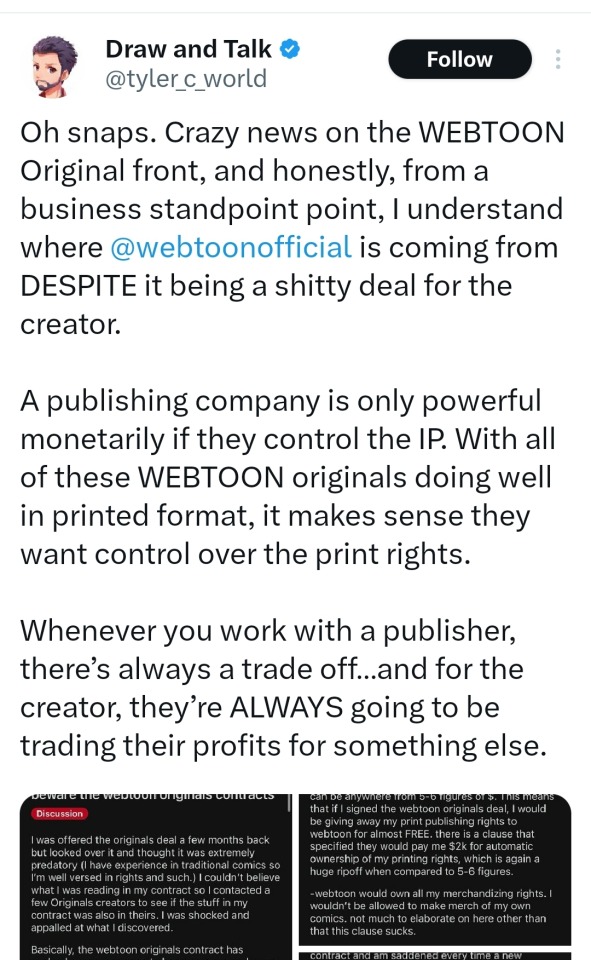

NOBODY needs to be defending these people. Major publishers, studios, streaming services, Tesla, Apple, Adobe, Amazon, social media companies- there isnt a single altruistic bone caught in their teeth. Profit from the output of exploited and captive labor IS their product now. When their contacts look like the one in question, the company is clearly stating that shareholders are the customers, not us!
Why else would it be anything but a stupid idea for Amazon to just nuke the majority of Comixology's self-published titles when they consolidated their services? If our experience was really foremost in their minds, why would they repeatedly purge, censor, demonitize, bury, and delete popular accounts with robust followings if not to allay the moral brainworms of shareholders and investors?
Forfeiting rights to our IP is not a "shitty deal," it's surrendering any potential ability to make money off of your own creative work. It's selling your property to a board of accountants to pitch into a portfolio. It's theirs to trot out as long as it's profitable and bury the instant its projected profit dips too close to the cost of maintenance. Hell, we've seen services drop popular series just because their projected profits started to flatten out! Mothballing it also has the added bonus of removing it from the market to further minimize potential competition. Like how there just weren't spider man movies for ages because the owner of the property didn't think it was worth developing but worth too much to sell.
They will make more money from suing you for trying to reclaim IP they mothballed than you did selling it to them in the first place. I guaranteee their budget for lawsuits is a lot deeper than the one they pay their "original" artists from.
By virtue of being a big, profitable, corporation, "their" IP is going to have an astronomically higher value in a court of law than any individual creator. The financial "damage" will be higher for infringing on their copyrights than any amount you can claim on your own. When it becomes theirs, their connections, their infrastructure, their reputation makes it an asset with much more value than you or I can possibly claim. So if you try to steal a bite back from them it's a bite of a *potentially* multimillion-dollar series. In their eyes, they bought the totality of your work, which you agreed was worth the price they gave you. It's value becomes more dependent on who owns it than whether it's even good.
You may not have the same potential to become flash-in-the-pan, short-term succesful without their resources, but you will still own your rights to distribute, alter, preserve, promote, and negotiate your share if you still own your work. That is worth everything as a creator who is passionate about what you've made and committed to protecting it.
The most effective power we can exercise as artists is our ability to say, "no" when someone else wants to pay us a disadvantageous fraction of our worth. You may lose potentially lucrative opportunities but "opportunities" presented by companies like Facebook or Twitter, whose real product is a platform for ads and data collection, with content as bait, are not opportunities to thrive on as independent artists. This specifically is an opportunity for the company to acquire property.
The myth that the publisher's strength is something for us to exploit, without them getting the lion's share is a trap that they feed from at will.
People like the poster up top are opportunists who see the process as a pipeline towards trading low-investment content for financial treats and maybe a share of ad revive. They're stalking horses for companies to exploit more talented but less experienced artists who are facing a daunting and overwhelming market where their work becomes harder and harder to show, let alone sell. A quick deal may feel like a win but it's selling the cow to save money on bottling the milk. Artists like this serve the publisher by making it seem like signing away your rights are just a necessary part of the game. However it's a game they are playing with exceedingly cheap stakes that weren't going to succeed on their own merit. So what if Mr. Business Perspective loses rights to his sexy Mario Bros. parody to a huge company? The point was always to unload it because it's a product, a bartering chip, a trinket. He's a Business Man, so he sees tactics that maximize profits to the business as maximizing their ability to buy whatever shiny tripe he cranks out. The business is his customer, not the reader. The business is his ally, not the creative community. Fuck him and fuck anyone who tells you the exposure is worth a damn if you don't retain rights to your work.

116 notes
·
View notes
Text
despite my lack of enjoyment for most of the atla post-series comics themselves, i'm very fascinated by the discussions around them because, as with many post-series comics, two of the biggest questions are: are these canon? and does that matter?
it's interesting, too, because i have never seen a single post-series comics continuation that was widely well-received. which is not to say that no one enjoys them - you can find avid supports and avid detractors for just about any property and any storytelling medium you can think of - but that the contention around them is not contained just to atla. (the buffy post-series continuation comics, for example, are pretty controversial as well.)
i think part of it comes down to fan resentment, because as much people say they want more of a certain thing, it's actually often better, at least i think, for a creative project to be self-contained and not try to keep milking the cash cow. and when creators are doing that and not delivering a story fans are happy with, it shows.
but then that also leads to this question, right, of are these post-series comics canon? i think the answer is genuinely more nuanced than some have given thought to. bryke would say yes, as they are the official creators and have been heavily involved in the production of the comics. and anyone who subscribes to the idea that the original creators of a thing hold the final word on the idea of what's canon and what's not would therefore agree also.
but if someone was more inclined to think that once a creator puts their work out into the world, they're sort of giving up the the idea that they have total control as to how people interpret the thing they've created... then it's a lot murkier.
i guess, to be clear, i do not, strictly speaking, see the atla comics as canon. i'm not the type (at least these days, there's a lot of past fandom follow-the-leader-ing i was doing that i now cringe back at, i was sixteen, it's fine) to declare something as 'not canon' if i simply don't like it. i think that's important to acknowledge because sometimes canon is worth criticizing. this is, incidentally, where i (again, these days) find myself uninterested, by and large, in deriding a character for behaving 'ooc', and instead far more interested in contextualizing and analyzing their behavior. after all, if it's in the thing, it’s in the thing.
... except the comics aren't the original thing. they are influenced and backed by the original creators and presumably a lot of people on the original team, but they're an entirely different medium, and presumably not entirely the same team, and they may well have had a very different artistic mission statement or way of brainstorming ideas, etc, etc. (also, to anyone who says the medium does not matter, i implore you to think about how different the show would be with a different musical score! for an instance. and then think about the fact for as big an influence as the music had on the series, the comics inherently cannot translate that.)
which leads me to a rabbit-hole train of thought question there is, i think, no clear answer to, but i will pose it regardless: can something made (at least in part) by the original creators be a 'transformative work'? if you're defining 'transformative' as: "adds "new expression, meaning, or message" to the original work", then i think you could easily argue that the new medium, if nothing else, constitutes a 'new expression.' but then you could also argue that the whole point of the term is to protect creators of transformative works from copyright claims made by the original creators, arguably making that irrelevant.
anyway! even more than the nebulous nature of what a post-canon comic even is, i find fan engagement - or lack thereof - pretty important to the conversation, too. because i think those of us deeply entrenched in fandom spaces tend to forget that casual viewership probably takes up a much larger percentage of most audiences than those in fandom, and that's probably true even years after a show has ended. that being the case, a lot of the audience has probably never even heard of the comics, let alone read them.
there are, naturally, nuances and variables to this, such as the idea that someone who goes back and watches a show from twenty years ago might be more likely to engage in fandom, and the way that 'fandom' has a concept has evolved (as i do think what i'd term 'casual fandom', eg. tweeting about bridgerton but not necessarily consuming or creating fan content is a lot more common now than it was twenty years ago due to social media), as well as the fact that you don't have to be involved in fandom to say, receive the comics as a gift from an uncle who knows you like the franchise.
but all of this can be true and it can also still be true that a pretty big percentage of people who have watched and even love atla haven't read the comics/have no knowledge or interest in them. and so that gets to the issue of does it matter whether they're canon or not? i've seen some KA shippers, for instance, argue that the comics 'fixed' the issue of aang kissing katara without her consent in teip because there's a comic (iirc) where he asks if he can kiss her, she says not right now, he listens, the end. and to be clear, i'm not trying to demean the creators for including that scene, as i think it's important to model healthy examples of consent for kids. but i also really empathize with the idea that it's sort of too-little-too-late because the original issue was never addressed in-show and, again! many people who did watch the show have never and will never read that comic.
so when i hear the debates back-and-forth of whether they count as canon or not, my head hurts, and i just can't find it in myself to care. who knows, right? maybe the real canon is the friends we made along the way. etc.
what it boils down to for me is this: generally speaking, i don't enjoy the comics and have no need or desire to incorporate them into my understanding of atla's series narrative. there are elements that i can appreciate, and they are largely zuko and the fn royal family backstory details, because, unlike the additive adventure narratives, it primarily serves to deepen and contextualize things we already saw in the show. i know some people see this 'i take what i like and dump out the rest' philosophy as, idk, a cheap cop-out or something. maybe they're right! i just can't find it in myself to care. at the end of the day, i think the big important thing for me is that i am able to define and decide on these things for myself. i think we should get more comfortable doing that in fandom in general, tbh.
#i swear i had a point with this. BEGGING someone to tell me what it was lol. this is not well-worded or particularly coherent sorry#this is a post that interests me and maybe three other people and to them i say what's up besties ily!#long post //#atla#sort of?#is this metacommentary. am i using that word right.#it's been a long day.#for entirely unrelated reasons lol#antikataang#jic
30 notes
·
View notes
Text
It's so strange how the problems that come with existing online have forced me to find words to explain concepts that I assumed were mostly universal. I thought knowledge, talent, expertise, hard work and persistence were skills that were valuable and should be encouraged in everyone. A.I. has taught me otherwise.
A.I. might as well stand for Anti-Intellectualism, because that's the spirit behind the excitement. It literally takes the skill and labor out of skilled labor. Learning is being treated like an inconvenience, a problem to be eliminated in the name of efficiency. Entire disciplines are being treated as grand sacrifices in the name of mass production and instant gratification.
Why does art need to be efficient? It's not food. It's not medicine. It's not shelter. How fast are people shoveling content into their gob that between social media, streaming, and physical media, it's still not enough? Technology has already pushed creators to pumping out content at an unhealthy and unnatural rate just to try to appease social media algorithms. Now that same output is being used to train new algorithms to pump it out even faster while cutting creators out entirely. It’s sick and cruel. And instead of this exploitation being treated like an injustice that needs to be corrected, I'm told "It's inevitable. Adapt or die. Don't put your work online if you don't want it taken", delivered either with condescending pity, callous apathy, or malicious glee.
If A.I. fans aren't taking the "hardened pragmatic realist" approach, then they are shallowly aping socialist ideas, blaming capitalism for exploitation, not the tech. A very "guns don't kill people, people kill people" take. Just because exploitation of creatives is not a new concept doesn't mean A.I. isn't responsible for making it INFINITELY WORSE. They’ve also decided that people shouldn't be pursuing art and knowledge for the sake of profit and that the skilled creators trying to protect their labor are greedy, elitist gatekeepers trying to keep art from "the common man" (because creatives aren't the common man, apparently). It's that same resentment and distrust of experts that's typical of anti-intellectualism, except creative fields are in this weird place where they aren't even respected the way STEM is, so there's an extra layer of belittling and disrespect to the othering. Consumers feel entitled to art, but they don't understand how it's made, and they definitely don't respect it as a discipline.
The glut of creative content available for "the common man" to consume has never been greater or more accessible, but it's still not enough. It's not enough to just consume art. They want ownership. They want the sense of accomplishment that comes from making something, without having actually *made* it. And despite their finger-wagging at creatives wanting to protect their careers, they also want to make some money. Etsy is flooded with A.I. prints, kindle is filled with A.I. books, spotify is loaded with A.I. songs. There’s even A.I. kickstarters. Along with replacing writers and animators, CEOs want to replace actors, voice actors, and models with simulacrums they can make do whatever they want, forever, and A.I. fans are hoping they'll be the ones hired to facilitate that process. Even without actively profiting, A.I. still devalues the work of skilled laborers. Why commission a skilled artist when for 15 dollars you can buy a machine that will give you infinite works of the same or better quality, instantly? Do you have faith in consumers to prioritize ethics over convenience? Do you think it's right and fair and good to make compensating skilled creators an act of charity rather than a necessity?
A.I. users overestimate their contribution to the final product, thinking their idea is so unique and their vision so strong, that of course they should claim ownership… conveniently ignoring all the infinite little decisions A.I. made for them based off the knowledge and fine motor skills of millions of artists. It's like they think fully realized Good Ideas are a natural resource waiting to be excavated, and traditional creators had the unfair advantage of pickaxes, physical strength and a knowledge of geology to find the rich veins. Now A.I. is providing scanners and and powerful machinery so "the common man" doesn't need strength or knowledge to quickly mine those same veins first.
But that's not what art is, and that's not how creation works. Art is communication. Imagination is fostered through life experience, observation and processing information with your human brain. It's something every living person could do, because every person is unique with unique life experiences. Creation is practice, study, experimentation, problem solving, and adapting to limitations. There is nothing stopping anyone from doing these things. Natural ability has been grossly overvalued: most people with "talent" were not making hyper-realistic paintings at 13 like Picasso. What happens is a child shows a slight aptitude, the adults in their life notice and give them positive reinforcement, and then they are motivated and encouraged to pursue that interest. So instead of treating the naturally talented as having an unfair advantage, why not blame the adults in your life for not encouraging your interests at a young age. Or if you want to be brutally honest, blame yourself for not pursuing your interests despite a lack of external validation. You have agency.
I try to imagine, what is an A.I. fan's idea of a perfect future? One where no one has any advantages that another person doesn't, where "everyone's special so no ones special"? Where all labor is automated and no one has to do anything they don't want to and everyone spends their infinite free time bettering themselves for it's own sake rather than for money? Every time they mention the evils of capitalism and how we need universal basic income and other ideas of a post-work society it makes me want to pull my hair out. We don't *have* those things. We aren't even close to those things. So it is functionally useless to factor that into your argument. Who is Tech to use A.I.'s elimination of thousands of jobs in non-Tech industries as a bargaining chip to try and incentivize the government to create safety nets for those displaced? Since when has your government prioritized it's citizens over corporations? Have proponents always been this naive, or only when trying to assuage concerns over the consequences of their new toy?
Even if we did achieve that techie utopia, what makes them think most people will use their free time productively, exercising their brain for it's own sake? Because speaking for myself, I can have every good intention of using my time to create and learn, but those things frequently lose out to short term, dopamine-driven feedback loops like social media and video games. Without any external incentives, I guarantee far less people will pursue learning for its own sake if the knowledge-based roles that keep society functioning are filled by machines. Think of how we've had to reintroduce exercise into are lives just for exercise's sake. Hows that going? Again, speaking for myself as an overweight person: Not Great. I might intellectually know physical fitness is important, but the difficulty and unenjoyable nature of exercise and the benefits not being immediate and obvious means it frequently loses out to activities I do enjoy. I know not everyone is like me, but many, many people are. Now replace physical fitness with cognitive abilities. Abilities that require work, who's benefits are totally abstract, and would be wholly unnecessary for living in an A.I dependent society. If that doesn't give you chills up your spine, then you must stand to benefit from a culture of stupidity that's hopelessly dependent on tech. And I hate you.
No ones going to read all this.
#AI#Tech#Art#Artists#creation#anti intellectualism#knowledge#labor#exploitation#Long#word dump#future
55 notes
·
View notes
Text
How Adobe is Shielding Artists from AI Misuse
New Post has been published on https://thedigitalinsider.com/how-adobe-is-shielding-artists-from-ai-misuse/
How Adobe is Shielding Artists from AI Misuse
In recent years, the growing ability of generative AI to create realistic visuals, mimic artistic styles, and produce entirely new forms of expression has redefined how art is made and experienced. While this transformation offers remarkable opportunities for innovation and productivity in the creative sector, it also raises concerns about intellectual property rights and the potential misuse of artistic works. A recent study found that 56% of creators believe generative AI poses a threat to them, primarily due to the unauthorized use of their work in training datasets. Recognizing this challenges, Adobe—an American software company known for its multimedia and creativity software products—is taking proactive measures to protect artists from AI misuse. In this article, we’ll explore how Adobe is empowering artists to safeguard their intellectual property in the face of evolving AI threats.
The Rise of AI in Creative Industries
Artificial intelligence is transforming the creative industries, reshaping how we create, edit, and engage with content. From generating music and designing graphics to writing scripts and building entire virtual worlds, AI-driven tools are evolving at a rapid pace. However, as AI’s capabilities expand, so do the challenges it presents—particularly for artists. Models like DALL-E and Midjourney can replicate famous styles or mimic artwork with impressive accuracy, often using publicly available images without consent. This raises serious legal and ethical concerns about copyright and artistic integrity. For many creators, the fear is that AI will learn from their copyrighted work and produce something similar, potentially diminishing the value of their art. The lack of clear legal frameworks for AI-generated content further complicates the issue, leaving the creative community vulnerable. To address these concerns, Adobe is taking proactive measures to develop technologies that can protect artists from the potential misuse of AI.
Adobe’s Content Authenticity Initiative (CAI)
One of Adobe’s most impactful efforts in protecting artists is its Content Authenticity Initiative (CAI). Launched in 2019, the CAI is a collaborative, open-source initiative that aims to provide creators with tools to verify the authenticity of their digital content. By embedding metadata into images and other digital files, Adobe enables artists to assert ownership and trace the origin of their work. This “digital fingerprint” not only ensures that creators are credited but also helps identify when and where their work has been altered or misused.
In addition to protecting copyrights, the CAI addresses the broader issue of content manipulation, which has become increasingly concerned with the rise of deepfakes and AI-generated images that distort reality. By enabling users to verify the provenance and authenticity of digital content, the CAI protects both artists and the public from deceptive or harmful uses of AI technology.
Adobe Firefly
In early 2023, Adobe launched Firefly, an AI-powered collection of creative tools designed to generate images, videos, and text effects using generative AI. One of the key features of Firefly is its underlying data model. Adobe has ensured that Firefly is trained entirely on legally sourced content, including Adobe Stock and publicly licensed or copyright-free images. By building a dataset that respects intellectual property, Adobe aims to mitigate the ethical concerns artists have expressed about their work being scraped from the web and used without their consent.
Additionally, Adobe has implemented licensing mechanisms within Firefly that empower artists to be part of the AI training process on their own terms. Artists can choose to license their work for use in Firefly’s dataset and are compensated if their work is used to train AI models or generate content. This not only ensures fair treatment but also creates a revenue stream for artists who wish to contribute to the AI revolution without compromising their rights.
Adobe’s Licensing Solutions
In addition to protecting the integrity of artistic work, Adobe has also focused on ensuring fair compensation for creators who contribute to the datasets used by AI models. Through Adobe Stock, artists can license their work to be used in various applications, including AI-generated art. Adobe’s compensation model allows artists to benefit from the growing use of AI in the creative sector, rather than being left behind or exploited.
By enabling proper licensing for stock content used in generative AI models, Adobe offers a sustainable way for artists to participate in the future of AI-powered creativity. This is especially important in an era where digital content is increasingly driven by machine learning algorithms. Adobe’s licensing solutions help bridge the gap between AI innovation and artist protection, ensuring that creators are rewarded for their contributions to these advanced technologies.
Protecting Artists in the Era of NFTs
Another area where Adobe is protecting artists from AI misuse is in the escalating field of non-fungible tokens (NFTs). As digital art becomes increasingly valuable in the NFT marketplace, artists face new risks from AI-driven art theft. Unauthorized copies of their work could be minted as NFTs without their knowledge or consent, undermining the ownership and value of their creations.
To combat this, Adobe has integrated CAI technology with leading NFT platforms like Rarible and KnownOrigin. By embedding CAI metadata into NFT art, Adobe allows artists to prove the originality and ownership of their digital work on the blockchain. This helps artists maintain control over their creations in the fast-moving NFT field, where authenticity is the key.
Furthermore, Adobe’s authentication tools are being expanded to include NFTs generated by AI. By binding AI-generated art to the same CAI standards, Adobe ensures that artists can trace and control how their work is used, even when it becomes part of an AI-generated output.
Adobe’s New Tool for Content Authenticity
Adobe recently unveiled a new web app set to launch in early 2025, designed to help creators protect their work from misuse by AI. This app is part of Adobe’s enhanced Content Credentials system, enabling artists to easily add their information—such as name, website, and social media links—directly to their digital creations, including images, videos, and audio.
A key feature of the app is the option for users to opt out of having their work used to train AI models. This directly addresses the growing concerns among artists about their creations being utilized without permission in generative AI datasets. The app also simplifies the tedious process of submitting requests to various AI providers.
Additionally, the app integrates with Adobe’s well-known platforms like Photoshop and Firefly, while also supporting content created with non-Adobe tools. Users can embed tamper-evident metadata, ensuring their work remains protected, even if it’s altered or screenshot.
The Bottom Line
Adobe’s efforts to shield artists from AI misuse demonstrate a forward-thinking approach to an urgent issue in the creative world. With initiatives like the Content Authenticity Initiative, the ethical training models of Firefly, and licensing solutions such as Adobe Stock along with the new content authenticity web tool, Adobe is laying the groundwork for a future where AI serves as a tool for creators rather than a threat to their creativity. As the distinction between AI-generated and human-made art becomes increasingly unclear, Adobe’s dedication to transparency, fairness, and empowering artists plays a crucial role in keeping creativity firmly in the hands of creators.
#2023#ADD#adobe#Adobe Stock#ai#AI in Creative Industries#AI models#ai training#ai-generated content#AI-powered#Algorithms#American#app#applications#approach#Art#Article#Artificial Intelligence#artists#audio#authentication#Blockchain#bridge#Building#CAI#collaborative#Community#content#Content Authenticity Initiative#copyright
2 notes
·
View notes
Text
Meta AI Chatbot Now Available to WhatsApp Users in USA, Here Is How It Works
Introduction:
In the ever-evolving digital landscape, artificial intelligence has become an integral part of our daily lives. Among the pioneers in AI technology is Meta AI, a cutting-edge language model designed to assist and augment human capabilities. In this article, we will delve into the world of Meta AI, exploring its features, capabilities, and potential applications. Buckle up for a comprehensive journey into the future of AI!
Understanding Meta AI:
Meta AI is a highly advanced language model developed to process and generate human-like text. Trained on a massive dataset of text from the internet, Meta AI boasts an impressive range of capabilities, including:
* Answering questions * Providing definitions * Generating text * Conversing on various topics * Offering suggestions and ideas
How Does Meta AI Work?
Meta AI functions by using a combination of natural language processing (NLP) and deep learning algorithms. These technologies enable the model to understand and generate text based on patterns and relationships learned from its vast training dataset.
Features and Capabilities:
1. Question Answering: Meta AI can provide accurate answers to a wide range of questions, from simple queries to more complex topics. 2. Text Generation: Need help with writing? Meta AI can generate text on a given topic or subject, making it a valuable tool for writers and content creators. 3. Conversations: Engage in natural-sounding conversations with Meta AI, perfect for practicing languages or exploring new ideas. 4. Summarization: Get quick summaries of long texts or articles, saving you time and effort. 5. Creative Writing: Collaborate with Meta AI to generate poetry, stories, or even entire scripts!
Applications and Integrations:
1. Education: Meta AI can assist students with research, homework, and language learning. 2. Content Creation: Use Meta AI to generate ideas, outlines, or even entire articles, blog posts, or social media content. 3. Customer Service: Implement Meta AI as a chatbot to provide 24/7 support and answers to frequent questions. 4. Research and Development: Accelerate your research with Meta AI's ability to summarize and analyze large texts. 5. Accessibility: Meta AI can aid individuals with disabilities, such as reading text aloud or providing assistance with writing.
Ethics and Responsibility:
As AI technology advances, it's essential to address ethical considerations and ensure responsible use. Meta AI is designed to operate within ethical guidelines, including:
* Transparency: Clearly indicating when responses are generated by AI. * Bias reduction: Continuously updating and improving to minimize biases. * Privacy: Protecting user data and adhering to privacy regulations.
Conclusion:
Meta AI represents a significant leap forward in AI capabilities, offering a powerful tool for various applications and integrations. By understanding and harnessing the potential of Meta AI, we can enhance our productivity, creativity, and knowledge. Embrace the future of AI and explore the possibilities with Meta AI!
For more update Visit Info Ki Dunya
2 notes
·
View notes
Text
Nike ISPA Link Axis,

According to NIKE
Make the bold bolder. That’s the vibe of the new Nike ISPA Link Axis, Nike’s first exploration into creating a fully circular shoe, furthering its culture of innovation.
Every part of the Link Axis can be recycled. The design uses interlocking components, as few materials as possible and zero glue. The Link Axis has a 100 percent recycled polyester Flyknit upper that’s precisely engineered to fit over the outsole (compared to the traditional cut-and-sew method used for the Nike ISPA Link), and its 100 percent recycled TPU tooling was achieved by using scrap airbag material. The shoe also has a 20 percent recycled TPU cage. Because recycling changes some material properties, the cage is an exercise in balancing the desire to use recycled content with the need for durability and traction.
These industry-pushing innovations are thanks to the Nike ISPA team. ISPA (Improvise, Scavenge, Protect, Adapt) is a Nike design philosophy that challenges creators to experiment, break molds and reimagine products. In the case of the Link Axis, it helps move Nike closer to its circular vision — a closed-loop system that yields no waste — to help protect the planet and the future of sport.
For more than 30 years, Nike teams have pursued design solutions in service of the athlete and the planet. They’ve unlocked new, lower-impact materials (see: Nike Grind, Nike Air) and created pinnacle performance footwear and iconic lifestyle silhouettes leveraging recycled content (see: Alphafly Next Nature, the Move to Zero collections). As the climate crisis has intensified for athletes around the world, Nike teams have shifted into a higher gear, embracing circular design principles as creative accelerants. Those include the 10 principles outlined in the Nike 2019 Circular Design Guide, an open-source workbook to share learnings and insights with the larger design community and anyone interested in how design can help lessen impact on the planet.
For the Link Axis, the ISPA team considered the circular design principle of “disassembly,” or the ability to easily take a product apart to recycle its components, one of the more challenging principles to implement in footwear design. A good shoe is flexible and durable. Traditionally, designers use glue and other bonding elements to achieve these aims, but that makes a shoe nearly impossible to disassemble and recycle. Recycling shoes usually requires shredding, an energy-intensive process that limits how the recycled materials can be used. Creating a shoe that can be taken apart would reduce the carbon footprint of the product and open up new possibilities for its life cycle.
The Link Axis is the new pinnacle for disassembly and embodies the circular design principles of material choice, waste avoidance and refurbishment.
The Link Axis arrives in a Total Orange and Sonic Yellow colorway — a nod to the first Link Axis prototype — and is available September 12 on SNKRS.
To learn more about how and why Nike created the ISPA Link Axis, check out "Why Nike Is Making Shoes You Can Take Apart."
ISPA Link Axis
















2 notes
·
View notes
Text
Why You Need a Freelance Content Creation Contract
As a freelancer, you likely know how important it is to have a contract when working with clients. But what about a freelance content creation contract? This type of contract can be beneficial for both you and your client. Here are three reasons why you need a freelance content creation contract:
It protects your work – When you have a contract in place, your client cannot make changes to your work without your approval. This means that they cannot take credit for your ideas or post inaccurate information.
You will get paid on time – A contract ensures that you will be paid promptly for the work that you do. Without one, there is always the potential for payment delays or non-payment altogether.
It defines expectations – By having a clear and concise contracts, both parties knows what is expected of them throughout the duration of the project. There are no surprises and everyone is on the same page from start to finish.
In today’s business world, there are many benefits to having a freelance content creation contract in place before starting any project big or small. These contracts help protect not only the quality of your work but also ensure timely payments and lay out all expectations upfront so there are no surprises later on down the road during production.. If you’re ready to get started with drafting up an airtight agreement, contact us today!
What is a freelance content creation contract?
When you hire a freelancer to create content for you, it’s important to have a contract in place. This contract will protect both you and the freelancer, and will help ensure that everyone is on the same page regarding expectations, deadlines, intellectual property rights, and more.
A good freelance content creation contract should include:
-An overview of the project scope and objectives
-The roles and responsibilities of each party
-Terms regarding confidentiality and ownership of intellectual property
The advantages of a freelance content creation contract
As a freelance content creator, one of the most important tools you have at your disposal is a contract. A well-written contract can protect both you and your clients in case of any disagreements or problems that may arise during the course of your work together.
There are several advantages to having a contract for freelance content creation services. First, it spells out exactly what is expected of you as the freelancer. This can help avoid confusion or misunderstanding about the scope of work agreed upon. Second, a contract can provide some financial protection in case something goes wrong with the project or if the client fails to pay for completed work. Finally, having a contract helps to establish boundaries and expectations from the start, which can make working with clients much smoother overall.
If you’re thinking about entering into a freelance content creation agreement with someone, be sure to take these factors into consideration!
The disadvantages of a freelance content creation contract
When you’re a freelancer, one of the things you have to be careful about is signing contracts. A freelance content creation contract can be a great way to protect yourself and your work, but there are also some potential downside that you should be aware of before you sign on the dotted line.
One of the main disadvantages of a freelance content creation contract is that it can limit your creativity. If you’re entering into a contract with someone who has very specific ideas about what they want, it can be hard to feel like you have the freedom to really express yourself. This can lead to frustration on both your part and your client’s part, and ultimately result in subpar work.
Another disadvantage of a freelance content creation contract is that it can put pressure on deliverables. If you’ve agreed to produce X number of pieces by a certain date, and then life happens and things come up that prevent you from meeting that deadline, it can reflect poorly on you as a freelancer. This could damage your relationship with the client and make it difficult to get future work from them (or anyone else).
So while there are some definite benefits to signing a freelance content creation contract, make sure you weigh all the pros and cons carefully before making any decisions!
How to create a freelance content creation contract
When you’re ready to start working with a freelance content creator, it’s important to have a contract in place. This will protect both you and the freelancer, and help ensure that everyone is on the same page regarding what’s expected.
Creating a contract doesn’t have to be complicated or expensive – there are plenty of templates available online that you can customize to your specific needs. Just make sure that everything is clearly laid out before work begins, so there’s no confusion down the road.
Here are some key elements that should be included in any freelance content creation contract:
-Scope of work: This should detail what type of content will be created, how many pieces are required, and any other deliverables that are part of the project.
-Timeline: When do you need the finished product? Be realistic about deadlines, and allow enough time for revisions if necessary.
-Payment terms: How much will the freelancer be paid, and when? Will they receive partial payment upfront, or only after completion?
-Rights and ownership: Who owns the copyright to the finished work? Make sure this is clearly stated in order not to run into any legal issues later on.
Why you need a freelance content creation contract
As a freelance content creator, you likely already know the importance of having a contract in place before beginning work with a new client. Not only does a contract help to ensure that both you and your client are on the same page regarding expectations and deliverables, but it can also help to protect your legal rights in case of any disputes that may arise down the road.
While some freelancers choose to work without contracts, this is generally not advisable. A well-written contract can save you a lot of headaches later on, so it’s always worth taking the time to put one together before starting any new project.
When it comes to crafting a freelance content creation contract, there are a few key elements that should be included:
1. The scope of work: This section should outline exactly what type of content will be created, how many pieces need to be delivered, and by when they need to be completed. This helps to avoid misunderstandings further down the line about what was actually agreed upon.
2. Payment terms: Be sure to include information about how and when you will be paid for your services. It’s also important to specify whether payments are due upfront or upon completion of each assignment. If possible, try t
When do you need a freelance content creationcontract?
As a freelance content creator, you may find yourself working with clients who require a contract. This can be for many reasons, such as to protect their business interests or to ensure that both parties are clear on what is expected of the project.
When do you need a freelance content creation contract? If your client requests one, it’s generally a good idea to have one in place. Even if they don’t request one specifically, there are some situations where it might be beneficial to put a contract in writing anyway. Here are some examples:
If the project is large or complex: A contract can help define the scope of work and set expectations for deliverables and timelines upfront, which can avoid misunderstandings later on.
If you’re working with a new client: A contract can establish trust and provide peace of mind for both parties by spelling out exactly what will be delivered and when. It can also help prevent scope creep (when clients start making additional demands beyond what was originally agreed upon).
If you want protection against non-payment: Putting payment terms in writing helps minimize the risk of getting stiffed by a client after completing work. You can include clauses like “No payment shall be due until delivery of final product” or “All invoices must be paid within 30 days.”
Ultimately, whether or not to use a contract is up to you and your client – but if any of the above scenarios apply, it’s probably worth considering drafting one up!
What should be included in your freelancecontentcreationcontract
When you’re ready to start contracting your freelance content creation services, it’s important to have a clear and concise contract that outlines the scope of work and expectations on both sides. This will help ensure a smooth working relationship and avoid any misunderstandings down the road.
Here are some key elements that should be included in your freelance content creation contract:
1. Services Provided: Be clear about what types of content you will be creating for the client, such as blog posts, articles, social media copy, etc.
2. Deliverables: Specify how many pieces of content you will deliver per month or week, and when these deadlines are due.
3. Payment Terms: Outline how much you will be paid for your services, and whether this is a flat rate or hourly rate. Also specify when payment is due (e.g., upon completion of each deliverable or at the end of each month).
4.* Copyright: Include language specifying that all copyright ownership belongs to the client once they have paid for the work.*5 Revisions/Edits: Discuss how many rounds of revisions or edits are included in the price quoted before additional charges may apply.
Additionally, it’s always helpful to include contact information for both parties in case there are any questions or concerns throughout the duration of the project
Conclusion
As you can see, a freelance content creation contract is an essential tool for any freelancer. Not only does it protect your interests, but it also helps to ensure that both parties are clear about the scope of work and expectations. If you’re looking to hire a freelance content creator, be sure to request a contract upfront. And if you’re a freelancer yourself, always remember to ask your clients to sign one before starting any work.
The post “Why You Need a Freelance Content Creation Contract” appeared first on SwiftCreator.com.
https://ifttt.com/images/no_image_card.png https://swiftcreator.com/content-creation/why-you-need-a-freelance-content-creation-contract/
https://ifttt.com/images/no_image_card.png https://swiftcreator.weebly.com/swift-creator/why-you-need-a-freelance-content-creation-contract
2 notes
·
View notes
Text
Why can’t I write that this adventure is compatible with D&D?
I've been thinking about the Open Gaming License, and why even as I started creating 5e content, I never published it. Even the OGL 1.0a felt weird and restrictive to me.
Well today, the OGL has been functionally replaced by a radically lenient Creative Commons license for all 5e content that would use the SRD.
IANAL, but doesn't releasing the entire D&D 5.1 SRD under Creative Commons mean people can make D&D 5e adventures that point to non-SRD content? Content creators wouldn't have to abide by the absurd clause in the original OGL that says you can't mention D&D by name in your product.
For instance, could a 5e adventure designer insert a citation pointing to the page number for a non-SRD statblock in the Monster Manual? That's not an issue of copying IP because nothing is being copied. We simply were forbidden from citing books made by Wizards of the Coast under the terms of the OGL.
Ostensibly, this clause existed to protect Wizard's reputation. It served as a way to insulate the company from being associated with third party products they had no hand in.
Now, it seems like they can't do that anymore, at least for content written under the CC license. Granted, there is this sentence after the language releasing the SRD into the Creative Commons:
'Please do not include any other attribution regarding Wizards other than that provided above. You may, however, include a statement on your work that it is “compatible with fifth edition” or “5E compatible.”'
My understanding of how Creative Commons works means I don't think that's enforceable. As long as you're not misrepresenting your work as being approved by Wizards of the Coast, statements of compatibility like "compatible with D&D 5E" seem like they'll be completely legal. As well as other references to non-srd content, as long as you aren't copying them.
Anyway, I don't know whether or not I'll revisit any of those 5e adventures I shelved. Now that I've branched out to a bunch of different systems and my own, it's very clear to me that not every adventure is suited to 5e-style mechanics.
And does this reading feel right to other content creators? I almost worry this still falls into the murky territory of "well WOTC might try to sue you over it even if they're in the wrong, and what small creator could ever afford going to court over this?"
#ogl#dnd#ttrpg#tabletop#dnd 5e#law and legal system#open gaming license#josephines-design-thoughts#josephines-musings
4 notes
·
View notes
Text
#i got to screen Wish before it released during a school trip and let me tell you something #even though we noticed the glaring problems with that movie immediately #i also noticed something i dont think many others did at that time #there was so much talent and potential being held back. if you read closely you can pick up on a cry for help from the creatives behind it #i want to elaborate but i think if you know. you know #and if you don't.. this post does a good job of shining a light on a small part of that cry for you #despite its many issues i think i still liked Wish. Not because i think it was a good movie but bc i think it could have been a great one had circumstances been different. #my heart goes out to those who put their souls and everything they had into that movie and others in similar situations #some of the creators had given a small talk before the screening and to me they seemed very emotional about it #i think what many people forget is that nobody can see a project's flaws better than the people who worked on it #but what they also see and you can't is everything more it was meant to be #please remember that the core of many issues in any project is that the people with the talent often do not have power to call the shots
Yes, all of that. And I find it ironic that the gifed scene is the one that got people saying "Hey, King Magnifico's not really much of a villain, he's got a good point! He's just upholding his part of a social contract with his citizenry and doing what he, as king, needs to do to protect their wishes but also protect Rosas by ruling out granting any wishes that might backfire and have dangerous repercussions for the kingdom and the lives of the people! Asha's just an ignorant spoiled brat for demanding anything more of him! Magnifico Did Nothing Wrong!" So when you take that position on what you're being shown by the story and not scratching the surface to look at what Magnifico is doing in-universe by not giving back the wishes he knows he will not grant and knows the people who gave them to him cannot remember and what the out-of-universe subtext of this is, you're siding with the Disney Corporate Executive Overlords. You're siding with Bob Iger's "they're not being realistic with their expectations" argument. You're siding with Chapek and Iger's practices done under excuses like "It doesn't fit the Disney brand", "mass appeal stories over personal ones", "people don't want to go and pay to see movies with girly princess titles", etc. You're siding with their practices of dumping content straight to streaming (or onto Disney+ not too long after they've hit theaters or TV) even when that actually limits profits that the actual creative teams can make from their own work, of tampering with the artists visions and how the finished product turns out and then punishing those artists if it doesn't turn out well, and of ignoring ideas for original creations in favor of contiunally milking their popular (and profitable) existing IPs. You're siding with people who make up an entire entity that say loudly to the faces of all those who put in the work, the skills, the talent, the passion and dedication to create art and content they feel people deserve to enjoy, in the forms they deserve to enjoy them "I decide what everyone deserves!"
Capitalism errodes into a force for human evil when the people at the top prove susceptible to three things in excess beyond mere greed and self-interest: unchecked power, irresponsibility, and indecency. King Magnifico is allegorical for that evil, with a bit of a communist dictator angle to him too since that's the end point of those exact same excesses and extremes for socialism. He's a major problematic fave for all kinds of reasons, but anyone who wants to tell me he's a good guy can kindly GTFO.



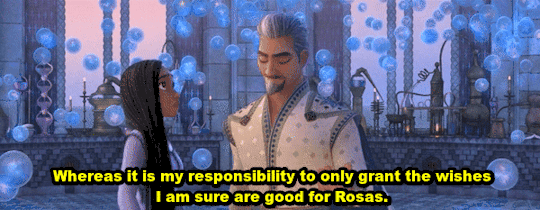

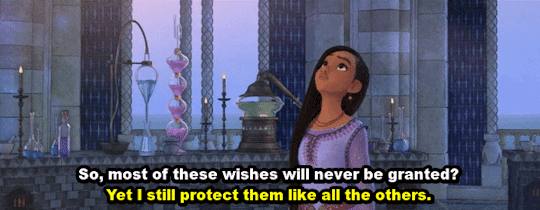

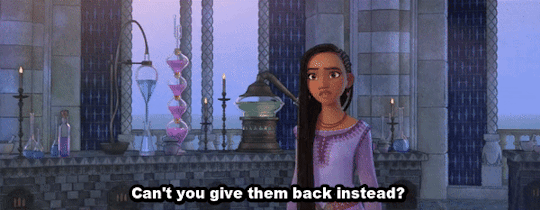

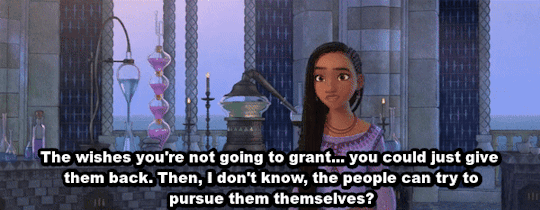



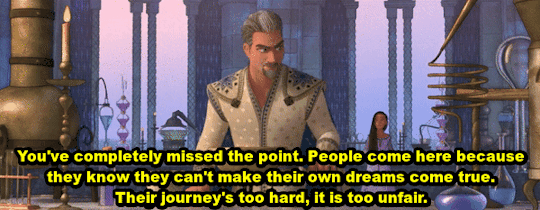

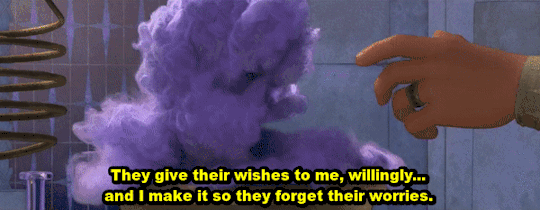
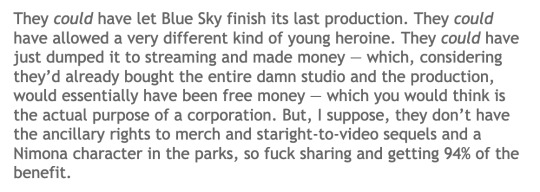
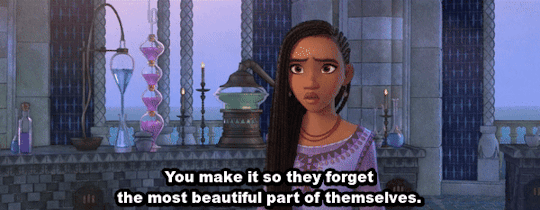

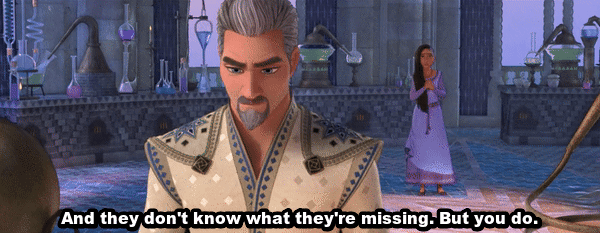

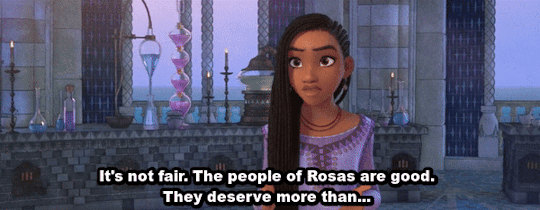

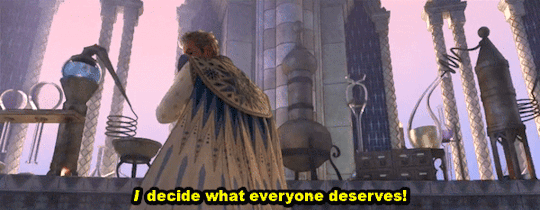

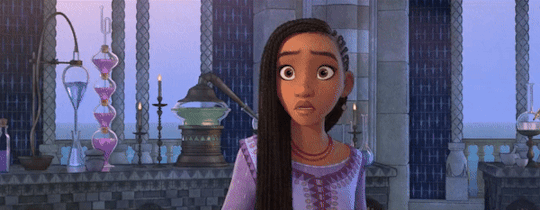


Wish (2023) dir. Fawn Veerasunthorn, Chris Buck
hey do you think the overworked creatives about to go on strike are trying to tell us something
article sources under the cut
Mattson, Kelcie. "How Disney Almost Killed 'Nimona.'" Collider, January 2 2024.
Earl, William. "Shelving Batgirl Was the Right Decision, Says New DC Studios Head Peter Safran: 'It Would Have Hurt DC.'" Variety, January 31 2023
Couch, Aaron. "Warner Bros. Reverses Course on 'Coyote vs. Acme' After Filmmakers Rebel." The Hollywood Reporter, November 13 2023.
Ridgely, Charlie. "Scoob! Sequel Director Revealed Film Was 'Very Close' to Completion Before HBO Max Cancellation." comicbook.com, August 2 2022.
Clark, Travis. "Staffers at the animation studio Blue Sky say it's 'heartbreaking' that Disney canceled its final movie, 'Nimona.'" Business Insider, February 18, 2021.
Harrison, Mark. "Why was the Batgirl movie cancelled?" Yahoo! Entertainment, January 31 2024.
Amidi, Amid. "Warner Bros. Shelves Fully-Completed 'Coyote Vs. Acme' For Tax Write-Off." Cartoon Brew, November 9 2023.
Lee, Alex. "Why Netflix keeps cancelling your favourite shows after two seasons." Wired UK, September 28 2020.
Tyrrell, Gary. "We All Knew It Was Coming." fleen.com, February 10 2021.
"Warner Bros. Reverses Course on ‘Coyote vs. Acme’ After Filmmakers Rebel." see: 3.
Bergeson, Samantha. "Warner Bros. Will Let 'Coyote Vs. Acme' Filmmakers Shop Movie to Other Distributors." IndieWire, November 13 2023.
Strapagiel, Lauren. "Disney's First Feature Animated Movie With Queer Leads May Never Be Released." BuzzfeedNews, February 24 2021.
"We All Knew It Was Coming." see: 9
@/scottderrickson. "I think it’s absolute bullshit that a studio can and does shelve the creative work of hundreds of people for a fucking tax break." Twitter, 10 Nov. 2023, 4:52 p.m..
#Disney#Wish#disney villains#King Magnifico#analysis#opinion#criticism#anti disney#anti capitalism#anti communism
12K notes
·
View notes
Text
AI Ownership Debate and new horizons for intertextuality
Tools like Midjourney, firefly and Chat have become hot topics in recent years, raising intriguing questions about the future of creative arts and its ownership. The potential of this technology through these tools is redefining our understanding of intertextuality.

In the past Intertextuality referred to the correlation of texts and how they reference each other. It acknowledges that all the texts exist with cultural and literary influences.
Generative AI, however, introduces a new dimension to intertextuality. By training on massive datasets of existing texts, images, and code, these AI models can generate new content that blends and reimagines elements from countless sources. Generative AI has given a new layer to the concept of intertextuality. These tools are trained on large language models with huge datasets of texts, images, videos and code. The capability of creating something new that is a blend of so many existing data elements is countless and unique.
The massive scale of these processes is constantly pushing and exploring the new frontiers of intertextuality The ability of AI to break existing data sets into words and subwords is called tokenisation. This process where sentences are divided into small keywords helps AI systems to understand, analyze and ultimately synthesize newer sentences.
These new advancements However present new challenges. The concerns of copyright, plagiarism and diminishing human creativity are present today more than ever before. A lot of artists recently have revolted against large language models using their original works to train their models. Hence, the big question of true ownership is raised.
The author argues that artificial intelligence (AI) can produce original work deserving of copyright protection. The
They discuss the history of copyright law and its challenges in the digital age, emphasising the unique nature of AI as a technology capable of independent learning and decision-making. The author also examines the concept of AI legal personhood and its implications for copyright ownership. The text discusses how artificial intelligence (AI) challenges copyright laws due to its ability to generate original content. The author explores AI's potential for legal personhood and copyright ownership, emphasising AI's unique capacity for independent learning and decision-making. The text also delves into the history of copyright law and its struggles to adapt to the digital age.
The Research paper discusses the fact that AI can generate original content that is worthy of copyright protection. At its heart, the AI and ownership debate is really a mirror of our own ever-changing relationship with creativity in the digital age. Are we at a point in time where the difference between human and machine-generated art is so indistinguishable that notions of 'authorship' become totally reimagined? It is at a precipice, not just technological but philosophical. As with more traditional forms of intertextuality, this new intertextuality that emerges from the wide neural networks of AI is not a simple collage of previously existing work. An ever-changing, shifting landscape of possibilities, a fact that speaks to the power of recombination and the infinity of inspiration whichever direction it will come from. This begs the question: Shouldn't we be remaining with old ownership models, or embracing an occasion where inventiveness is a joint, developing discussion between people and savvy programming?
In the end, though, it depends on how we choose to structure the world we are living in today for the future of art and intertextuality. It’s time to make a call as to whether our legal and ethical frameworks are fit to deal with this new reality while at the same time supporting the creation of new and innovative products and services without infringing on the rights of human creators. Maybe we ought to look at AI not as a threat to our artistic legacy but as an inventive partner pushing forward the limits of human imagination onto paths we don’t even know are out there yet. The journey ahead is uncertain, but one thing is clear: … might be the most human, creative act of all: embracing a future of shared creativity, based on a profoundly intertextual dance in which humans and AI are partners. It may be that we are on the threshold of the creation of a new artistic renaissance, but we are the only limit to that.
https://www.rand.org/pubs/perspectives/PEA3243-1.html
0 notes
Text
TLDR: yep, it's a problem. Best we can do is adopt and adapt to Ai.
I'm doing a degree in compsci right now and I agree. The cat is out of the bag. Ai is a tool that can do some really amazing things but right now it's being utilized for profit from bad actors or just theft. The next 2-3 years are going to be very hard for creatives because that's how long it will take to pass legislation to create a framework to wrangle AI use. And due to legal framework on the internet being all patchwork (which country is the company based in? where are it's servers located?) Legislation passed in one part of the world may not affect you depending on which websites you frequent (the USA is an exception due to it's large number of companies and servers on its soil).
The (good?) news is private companies will often follow the most restrictive internet laws if they want their business to be wide reaching. On the flip side, if you violate internet law from a certain country on a server/business in that same country, you may be extradited to face prosecution - may, because sometimes laws are unjust and your government may ignore the request (looking at Iran.) I'm just learning about all of this right now so it's fresh in my head.
Where does this leave artists and AI right now? Nowhere, there's no laws or protections yet. Perhaps in the future we will be able to curb what people do on the internet but we have never and will never be able to control what people do on their private devices. Perhaps in the future we will create a 'blue check mark' of artists and content creators that certify they're human and it is their stuff. Perhaps that will be undermined by new tactics/hacking/rampant AI drowning content out. Perhaps we will restrict AI LLM models with licensing and traceability. If they put a price tag on licensing, people will steal it and crack programs open and remove the tracing to avoid copyright laws, putting us back at square one. There are solutions to this problem but it will require radical new perspectives and novel tactics to design and enforce. Everything is work, nothing will settle into net positive system on it's own.
In passing I've heard about nightshade, but I don't know if it actually works. I suspect the enthusiasm for 100% Ai created art will die down after its novelty has worn off, but Ai produced art will remain. It will likely become a staple tool for digital artists of the future, creating graphic designers who do more curating and modifying than creating something from scratch (taste and aesthetics is a learned skill that comes from a constantly evolving culture, not something an Ai can understand ...for now.)
My advice is: don't avoid the technology. Learn it inside and out. Use it in experiments. Don't refuse to use this tool, because the people who want to profit off you absolutely will and it's not going away. Use it to your advantage. Keep looking for ways to protect your work. Use Ai to drown the internet in your intentional work that's produced at faster speeds. Or don't, maybe find a way to create things that the Ai just can't. Once upon a time commercial signage was produced all by the hand of artists. Now we have graphic designers designing and producing the work of 100 artists. The arms race of technology versus arts & trades has been going on for a long time, and likely will continue to. As an artist and someone learning code, we have got to adapt or we will be left behind because nobody is going to protect us from innovation.
Also, universal basic income is going to become a must to deal with Ai productivity going off the charts.
I think the best way to fight this AI shit is just to support actual creators. The cat's out of the bag with AI; our data's going to be taken and used without our consent whether we like it or not, so maybe we should put efforts into holding up those who create their own stuff. Comment/interact on people's writings and art. Make it worth them posting; make it clear that what the people are interested in isn't generated stuff, but things that people have actually done themselves. It's a drop in the ocean, but showing creators that it's them that deserve the support at least serves to cut off a tiny bit of oxygen to these AI hogs - and make a difference to creatives who are trying against hope to share with a community.
26K notes
·
View notes
Text

Tech Innovations of 2024 That Will Shape 2025
As 2024 winds down, it’s the perfect time to look back at some incredible tech innovations that defined the year. From revolutionary AI tools to advancements in blockchain technology, this year has set the stage for a tech-powered future. But here’s the exciting part: the innovations of 2024 are not just fleeting trends. They’re paving the way for even greater things in 2025 and beyond.
Let’s dive into the game-changing technologies of this year and explore how they’re shaping tomorrow.
AI and Automation: Transforming Industries Like Never Before
Artificial intelligence (AI) is no longer just a buzzword; it’s a reality that’s revolutionizing industries worldwide. In 2024, AI became smarter, more accessible, and surprisingly creative. From AI-driven customer support systems to tools that create unique marketing content in minutes, businesses have seen firsthand the power of automation.
Think about this: tasks that once took hours or even days can now be completed in mere seconds. That’s the magic of automation paired with AI. For example, e-commerce companies are using AI to predict customer preferences, offering hyper-personalized shopping experiences.
But it doesn’t stop there. AI has also made strides in healthcare, assisting doctors in diagnosing diseases faster and more accurately. These developments are not just about convenience; they’re literally saving lives. As we move into 2025, expect even more industries to adopt AI, reshaping how we work, live, and interact with technology.
Curious about how AI or automation could improve your business processes? Reach out to explore tailored tech solutions today!
Blockchain: Building Trust in a Digital-First World
2024 has been the year blockchain broke out of its crypto bubble and proved its worth across multiple sectors. Beyond cryptocurrencies, blockchain technology is now the backbone of supply chain management, ensuring transparency and security in every transaction.
Take logistics, for example. Companies are leveraging blockchain to track shipments in real-time, reducing fraud and improving accountability. It’s also being used in the food industry to trace products from farm to table, giving you peace of mind about what you’re eating.
And let’s not forget the creative industries! Blockchain is helping artists and creators protect their intellectual property through smart contracts and NFTs. This ensures fair compensation and ownership rights in the digital age. As 2025 approaches, blockchain will continue to build trust in areas like voting systems, identity verification, and even real estate.
IoT: Connecting Your World Like Never Before
If you thought smart devices were cool in 2023, 2024 took it to a whole new level. The Internet of Things (IoT) is no longer limited to just smart speakers or thermostats. This year, IoT expanded into areas like connected healthcare, smart cities, and even agriculture.
Imagine this: your city’s traffic lights communicate with your car to optimize your commute. Farmers monitor crop health remotely using IoT sensors, ensuring better yields and less waste. These are not distant possibilities—they’re happening now, thanks to IoT’s growing ecosystem.
The beauty of IoT lies in its ability to make life easier, more efficient, and even more sustainable. As we step into 2025, IoT is set to connect even more aspects of our daily lives, blending convenience with innovation.
How Can Your Business Ride the Tech Wave?
The best part about these innovations is that they’re not reserved for tech giants. Small and medium businesses are jumping on board too, finding creative ways to implement AI, blockchain, and IoT to streamline operations and delight customers.
But here’s the thing: staying ahead requires a proactive approach. Don’t wait for 2025 to roll around before exploring these technologies. Whether it’s upgrading your existing systems or diving into something entirely new, the time to act is now.
If you’re not sure where to start, don’t worry. The key is to identify your business’s unique challenges and match them with the right technology. You’d be surprised how even small tweaks can lead to significant improvements.
Closing Thoughts
The tech innovations of 2024 have set the tone for a dynamic, interconnected, and efficient 2025. From AI’s creativity to blockchain’s reliability and IoT’s seamless connectivity, the future has never looked brighter.
As we embrace these changes, one thing is clear: technology is not just transforming industries; it’s transforming lives.
So, are you ready to ride the wave and make 2025 your most innovative year yet?
Get in touch with Ariston to start your journey into the future of technology. Let’s build something extraordinary together!
#software#software development#web development#custom software development#ai#artificial intelligence#blockchain#iot
0 notes
Text
The Business Behind the Beat: Understanding the Commercial Side of Music
Music has always been more than just entertainment. It's a cultural force, a means of self-expression, and, significantly, a booming business. With the digital age transforming how music is produced, distributed, and consumed, understanding the business aspects of the industry has become essential. From song ownership to strategic use in advertising, music's commercial side is both intricate and fascinating.
The Importance of Music Ownership
In the past, determining who owns song was a straightforward matter. A songwriter or composer held the rights, and record labels managed distribution. However, in today’s world, things are more complicated. Digital platforms, collaborations, and licensing agreements have redefined ownership. This evolution raises questions for musicians and listeners alike. Who profits when a song goes viral on TikTok? What happens when multiple artists contribute to one track?
Artists need to protect their intellectual property to ensure they reap the benefits of their creativity. Simultaneously, fans benefit from understanding these dynamics, as it fosters transparency and encourages ethical consumption of music.
How Advertisements Leverage Music
Have you ever found yourself humming the tune of an ad long after it aired? That’s the power of a well-chosen soundtrack. Advertisements have always relied on music to create emotional connections, but in recent years, this practice has reached new heights. Consider the buzz surrounding the Amazon Prime ad song. These catchy tunes aren’t selected randomly—they’re meticulously chosen to evoke specific feelings and resonate with the target audience.
For advertisers, music serves as an emotional trigger. A nostalgic melody can remind viewers of simpler times, while an upbeat rhythm might inspire excitement. Brands also capitalize on trending songs to appeal to younger demographics, bridging the gap between marketing and pop culture.
Streaming Platforms and Music Controversies
The rise of streaming platforms like Spotify has democratized access to music, but it’s not without its challenges. Many artists have voiced concerns about unfair revenue distribution, leading to tensions within the industry. The term beef Spotify has become a buzzword for these disputes, highlighting the struggles musicians face in receiving fair compensation.
For listeners, these controversies can be eye-opening. They reveal the behind-the-scenes negotiations and conflicts that shape the music we enjoy daily. Understanding these dynamics fosters a greater appreciation for the work that goes into creating, distributing, and performing music.
Personalizing Social Media with Music
In the age of social media, music plays a crucial role in personal branding. Platforms like Instagram allow users to pair their posts with tracks, creating unique narratives and enhancing engagement. But how do you add your own music on Instagram? The process is surprisingly simple, enabling both casual users and influencers to customize their content.
Adding music to Instagram posts helps convey emotion, set the mood, and make content memorable. For businesses and creators, this feature is invaluable, offering a way to stand out in crowded feeds. It’s also a tool for promoting songs, as users sharing a track can introduce it to entirely new audiences.
The Role of Technology in Music Production
Creating high-quality music is no longer limited to professional studios. Technological advancements have made tools like the best sound card for live streaming singing accessible to anyone with a passion for music. These devices improve sound quality, making them essential for streamers, singers, and even podcasters.
For aspiring musicians, having the right equipment is often the first step toward success. Superior sound cards enhance clarity and reduce latency, ensuring that live performances sound polished and professional. This democratization of technology allows more creators to enter the field, enriching the music industry with diverse voices and styles.
The Future of Music Commercialization
As technology continues to evolve, the commercialization of music will adapt in tandem. Virtual reality concerts, AI-generated compositions, and blockchain for managing song ownership are just a few of the trends shaping the industry. These innovations promise exciting opportunities for both artists and consumers, blending creativity with cutting-edge tech.
For advertisers, music’s ability to connect with audiences on a personal level remains unmatched. From carefully curated playlists to exclusive collaborations with popular artists, brands will continue to explore innovative ways to integrate music into their strategies.
Conclusion
The business of music is as dynamic as the art form itself. From understanding who owns a song to leveraging the emotional power of a well-placed ad, the industry offers endless opportunities for growth and innovation. Whether you’re an artist, marketer, or listener, staying informed about these trends ensures you’re not just a spectator but an active participant in the evolution of music.
What’s your perspective on the commercial side of music? Share your thoughts in the comments below and let’s continue the conversation!
0 notes
Text
Today's longform content will be a reblog! Let's talk about how capitalism and copyright strangle originality!

I'm not ready to go full-manifesto yet, so let's confine this to the originality problem.
Human beings have always loved to tell stories. We especially love never-ending stories where we get to see our fictional friends go through all kinds of situations. Just look at how many variations we made of "trickster gets in over his head, and gets out again" before we ever dreamed of writing each tale down and selling them.
We now have collections of Coyote, Anansi and Robin Hood stories that, taken as a whole, look very much like a modern franchise or IP - including continuity errors and strikingly different takes on the characters and their situations. Aw, but we know ol' Robin when we see him - and if the "fandom" disagreed to strongly with the latest tale, the storyteller was standing right there on their level, free to be criticized or killed with a good-sized rock. Then someone else could take a turn.
This lateral structure - where the rules are established by mutual consent, and if we don't agree with the guy calling the shots, we punch them and it hurts - is still visible on playgrounds and around RPG tables today. But the big stories, the cultural touchstones, the "Intellectual Properties" worth buying, are subjected to a rigid top-down hierarchy, a profit-based selection model, and a "protection" system that can prevent even the people who came up with the original from us telling more of that story ever again.
Of course we want more Foster's. We loved Foster's! We didn't want it to end in the first place! But if it wasn't making enough money for the people producing and broadcasting it, and/or if the people who made the original were ready to make something else, what could we do? Fanfiction and fan animation are not impossible, but you can't offer them to a major production company, or sell them and buy food. And if your work starts to look a little too popular or legit, like it might threaten profits from the resale of the original, say hello to your takedown notice! The image of Bloo that exists in your memory and brain does not belong to you, because we lost our damn minds and decided ideas were property.

You can't just draw a mischievous little dome-shape with eyeballs and allow it to continue Bloo's adventures however you imagine. You can't re-tell any of his original adventures with your own spin either. Hamlet can reappear on stage nightly, with a rotating cast, set-design, and endless variations on the theme. Do you imagine Hamlet as a musical animated feature with lions in Africa? Wow! So creative! Have an Oscar or two!
But, wait! Wait-wait-wait! Doesn't copyright force you to go make a story of your own, with a trickster dissimilar enough not to get hit with a takedown? It's all well and good that Hamlet can hold up to endless reinterpretation, but if all we did was remake Hamlet, we'd never have Foster's!
What's that? Oh, no! It's Capitalism! With monopolization, corporatism, artificial scarcity, and a steel chair!
Even an original from an established creator has to run a gauntlet to get produced. 16 original ideas get gunned down like gangsters in the street, to say nothing of the infinite worlds imagined by more obscure creators (ahem) that don't even have the apparent financial viability to stagger their way up to Netflix and be killed.
This is not a process motivated by quality. A long crawl on their hands and knees over broken glass is standard for new creators, even the ones who go on to make billions. The Beatles got rejected by a record label on their way up because guitar groups were "on the way out." Nevermind that as soon as they dropped a little acid and earned a little clout, they were unlike any "guitar group" that came before. Guillermo del Toro relates the process of making his second film, and the first one that made it big, as "having a beautiful daughter and watching her arms get cut off." Mimic, as imagined, didn't look profitable, so the studio with the production rights tore it up until it did. We relate these stories as parables of tenacity, somehow ignoring the evidence that the system that produces and markets the stories we see has no idea what talent looks like.
New things, truly new and ground-breaking things, can only be compared to the things that came before them. If they don't fit into some existing standard, they'll be forced to fit. How else are we supposed to market and manufacture them?
"What's that thing?"

"It's a better mousetrap."
"What? Like a cat? Here, kitty-kitty. Here, kitty! Ow! Son of a gun, this is the worst cat I've ever seen!"
"No, no, it's a machine, it..."
"Hello, production? Yeah, can we get a couple dozen of these, but cover them in fur, give them some ears and a cute li'l bell, and get rid of this painful metal bit right here? And get me a couple focus groups, I think mostly ladies. Ladies love a kitty..."
"Wait! It won't WORK if you..."
"Listen, pal, I'm agreeing to produce your shitty cat, but if we can't get the major pet stores interested, I'm afraid you'll have to cover the costs and take a walk."
"Is there anyone else I can take this to?"
"Hmm, a few, but I promise they'll all tell you the same. Time is money, pal, what do you wanna do?"
"I guess if you let me talk to..."
"Swell. Sign over your rights on the dotted line right there and we'll get started."
Oddly enough, when you insist that an original look as much like the things that came before it as possible, it doesn't do very well. Or seem very original. But it makes success seem really difficult, and scarce, and it keeps new creators desperate, pliable, and cheap.
Coincidentally, it makes remakes, reboots and reimaginings look like a much safer investment. Intellectual Property is a cash cow offering exclusive ownership, and it takes a long time for everyone to notice the milk's started tasting a little off. As long as the corporation that wants to hire you is big enough to afford the the cow, chances are, they'll treat your creativity just like any other product. Your brain is the factory, and the best thing it can do is endless, industrialized repetition. Moo.
But, is that why we liked Foster's and wanted more of it? Because it was so consistent and samey? I thought we liked it because it was one of those rare, new, innovative things that made it through the process with most of its originality intact. We'd never seen anything like that before! We didn't know what was gonna happen next! With a shiny new interpretation, even tired old narrative tropes can be exciting.
"Wow, that's a cool trickster character."
"Thanks. I made him out of a child's imagination."

The endless repetition of reboots and remakes wouldn't be quite so repetitive if they didn't come off a corporate-owned assembly line. But the freeform chaos that claims stories from the public domain just isn't as controllable, or profitable. Who's getting the money off the rights to Hamlet? What? Nobody? Quick! Put that in a new package and copyright the shit out of it!

Ah. There. That's better. Well, better for the corporations.
Not for the creators. Or the stories. Or you.
Nice going, Capitalism and Copyright. Another case solved.
fucking constant reboot remake reboot remake reboot remake reboot remake!!!!!!!!!! the tv has only been around for like a century you literally cannot be out of ideas already
#capitalism#copyright#new stories#old stories made new#new stories inevitably made old though confinement and repetition#foster's home for imaginary friends#remakes#reboots#bloo lives in my mind now and you can't have him back#so the solution is to make sure no one ever sees what i imagine with him#sure that's not dystopian at all#no kings only fooles
122K notes
·
View notes